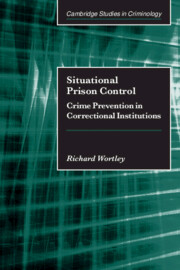Book contents
- Frontmatter
- Contents
- List of figures and tables
- Foreword
- Acknowledgements
- Part I Theoretical foundations
- Part II Specific behaviours
- 5 Prisoner-prisoner violence
- 6 Sexual assaults
- 7 Prisoner-staff violence
- 8 Self-harm
- 9 Drug use
- 10 Escapes
- 11 Collective disorder
- 12 Conclusions: hard and soft situational prison control
- List of references
- Index
8 - Self-harm
Published online by Cambridge University Press: 22 September 2009
- Frontmatter
- Contents
- List of figures and tables
- Foreword
- Acknowledgements
- Part I Theoretical foundations
- Part II Specific behaviours
- 5 Prisoner-prisoner violence
- 6 Sexual assaults
- 7 Prisoner-staff violence
- 8 Self-harm
- 9 Drug use
- 10 Escapes
- 11 Collective disorder
- 12 Conclusions: hard and soft situational prison control
- List of references
- Index
Summary
Perhaps of all the problem behaviours discussed in this book, deliberate self-harm by prisoners is most likely to attract dispositional explanations. This is a behaviour that is easily pathologised. Accordingly, much of the research in this area has been aimed at trying to identify those prisoners most at risk. This research has followed two lines of study. Some researchers have adopted a clinical approach, searching for psychological variables that might be useful in the development of risk-screening devices. Others have taken an actuarial approach, and examined risk in terms of established relationships with type of sentence, length of sentence, stage of sentence, prisoner race, psychiatric history and so forth (Salive et al., 1989).
In keeping with the focus of this book, research on individual-level risk factors is not reviewed in any depth here. This is not to say that many prisoners who engage in self-harm may not have particular psychological deficits and inadequate coping strategies that make them particularly suicide-prone, or that attempts to identify these prisoners are of no value. The situational approach, after all, is based on the assumption of an interaction between environment and disposition. However, there are dangers in placing too much faith in screening prisoners. Inevitably, at-risk prisoners will slip through the net. The argument of this chapter is that it is generally safer to assume that all prisoners are at risk and to focus on generic environmental contributors to self-harm.
- Type
- Chapter
- Information
- Situational Prison ControlCrime Prevention in Correctional Institutions, pp. 136 - 154Publisher: Cambridge University PressPrint publication year: 2002



